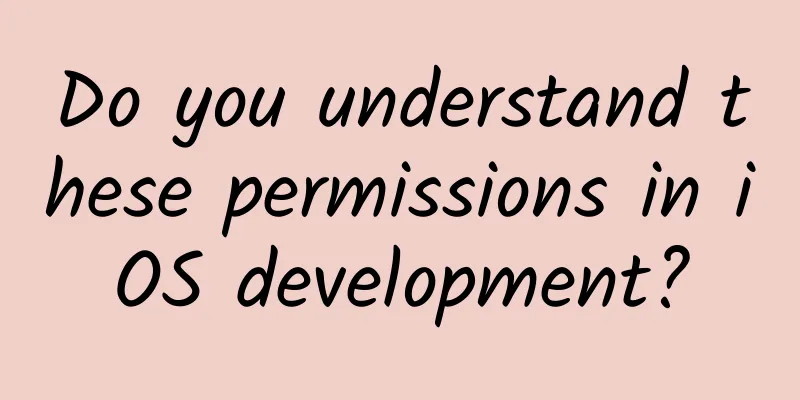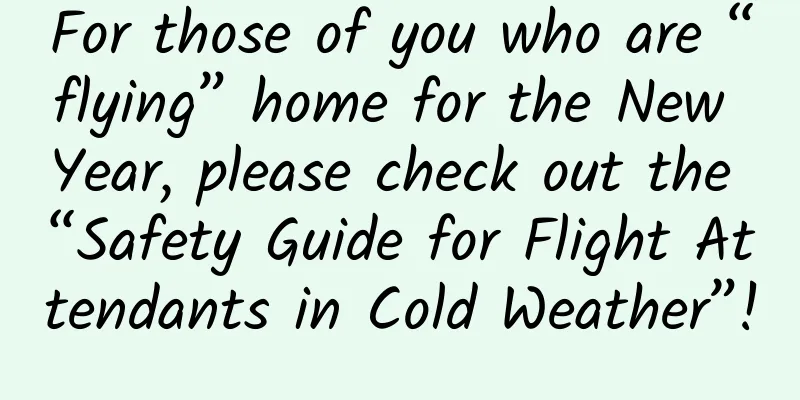|
Preface App development should avoid the problem of not opening system permissions. How to display system permissions to users in a more friendly way in the app seems to be something worth thinking about during the development process. So how to improve the success rate of APP obtaining iOS system permissions? There are several ways: - Request permission from the user when the user opens the app;
- After informing the user that they can get benefits by authorizing the permission, then ask the user for permission;
- Only request permission from the user when it is absolutely necessary, for example: requesting permission to access the system photo album when the user accesses the photo library;
- Before displaying the system permission dialog box, first display a custom dialog box to the user. If the user chooses not to allow, no operation is performed by default. If the user chooses to allow, the system dialog box is displayed.
The above situation is often encountered during the development process, and different choices will affect the final user interaction experience. This insight comes from the problem I encountered at work last week: adapting to iOS10, how to obtain application network permissions to manage the display management of system dialog boxes. After I solved this problem, I felt it necessary to summarize the commonly used iOS system permissions for future use. Permission classification - Networking permissions
- Album permissions
- Camera and microphone permissions
- Location Permissions
- Push permissions
- Contacts permissions
- Calendar, memo permissions
Networking permissions Import the header file @import CoreTelephony; After the application is started, check whether the application has Internet access permission - CTCellularData *cellularData = [[CTCellularData alloc]init];
- cellularData.cellularDataRestrictionDidUpdateNotifier = ^(CTCellularDataRestrictedState state){
- //Get the network status
- switch (state) {
- case kCTCellularDataRestricted:
- NSLog(@ "Restricrted" );
- break;
- case kCTCellularDataNotRestricted:
- NSLog(@ "Not Restricted" );
- break;
- case kCTCellularDataRestrictedStateUnknown:
- NSLog(@ "Unknown" );
- break;
- default :
- break;
- };
- };
Check whether the application has Internet access - CTCellularData *cellularData = [[CTCellularData alloc]init];
- CTCellularDataRestrictedState state = cellularData.restrictedState;
- switch (state) {
- case kCTCellularDataRestricted:
- NSLog(@ "Restricrted" );
- break;
- case kCTCellularDataNotRestricted:
- NSLog(@ "Not Restricted" );
- break;
- case kCTCellularDataRestrictedStateUnknown:
- NSLog(@ "Unknown" );
- break;
- default :
- break;
- }
Album permissions--before IOS 9.0 Import header file @import AssetsLibrary; Check if you have album permissions - ALAuthorizationStatus status = [ALAssetsLibrary authorizationStatus];
- switch (status) {
- case ALAuthorizationStatusAuthorized:
- NSLog(@ "Authorized" );
- break;
- case ALAuthorizationStatusDenied:
- NSLog(@ "Denied" );
- break;
- case ALAuthorizationStatusNotDetermined:
- NSLog(@ "not Determined" );
- break;
- case ALAuthorizationStatusRestricted:
- NSLog(@ "Restricted" );
- break;
-
- default :
- break;
- }
Album permissions--iOS 8.0 and later Import header file @import Photos; Check if you have album permissions - PHAuthorizationStatus photoAuthorStatus = [PHPhotoLibrary authorizationStatus];
- switch (photoAuthorStatus) {
- case PHAuthorizationStatusAuthorized:
- NSLog(@ "Authorized" );
- break;
- case PHAuthorizationStatusDenied:
- NSLog(@ "Denied" );
- break;
- case PHAuthorizationStatusNotDetermined:
- NSLog(@ "not Determined" );
- break;
- case PHAuthorizationStatusRestricted:
- NSLog(@ "Restricted" );
- break;
- default :
- break;
- }
![Uploading 144446-b8aca7ba38c5f8c0_695906.png . . .]Get album permissions - [PHPhotoLibrary requestAuthorization:^(PHAuthorizationStatus status) {
- if (status == PHAuthorizationStatusAuthorized) {
- NSLog(@ "Authorized" );
- } else {
- NSLog(@ "Denied or Restricted" );
- }
- }];
Camera and microphone permissions Import header file @import AVFoundation; Check if you have camera or microphone permissions - AVAuthorizationStatus AVstatus = [AVCaptureDevice authorizationStatusForMediaType:AVMediaTypeVideo];//Camera permissions
- AVAuthorizationStatus AVstatus = [AVCaptureDevice authorizationStatusForMediaType:AVMediaTypeAudio]; //Microphone permission
-
- switch (AVstatus) {
- case AVAuthorizationStatusAuthorized:
- NSLog(@ "Authorized" );
- break;
- case AVAuthorizationStatusDenied:
- NSLog(@ "Denied" );
- break;
- case AVAuthorizationStatusNotDetermined:
- NSLog(@ "not Determined" );
- break;
- case AVAuthorizationStatusRestricted:
- NSLog(@ "Restricted" );
- break;
- default :
- break;
- }
Get camera or microphone permissions - [AVCaptureDevice requestAccessForMediaType:AVMediaTypeVideo completionHandler:^(BOOL granted) {//Camera permissions
- if (granted) {
- NSLog(@ "Authorized" );
- } else {
- NSLog(@ "Denied or Restricted" );
- }
- }];
-
- [AVCaptureDevice requestAccessForMediaType:AVMediaTypeAudio completionHandler:^(BOOL granted) {//Microphone permission
- if (granted) {
- NSLog(@ "Authorized" );
- } else {
- NSLog(@ "Denied or Restricted" );
- }
- }];
Location Permissions Import header file @import CoreLocation; Due to the change of positioning method after iOS8.0, it needs to be configured in info.plist; Check whether you have location permission - BOOL isLocation = [CLLocationManager locationServicesEnabled];
- if (!isLocation) {
- NSLog(@ "not turn on the location" );
- }
- CLAuthorizationStatus CLstatus = [CLLocationManager authorizationStatus];
- switch (CLstatus) {
- case kCLAuthorizationStatusAuthorizedAlways:
- NSLog(@ "Always Authorized" );
- break;
- case kCLAuthorizationStatusAuthorizedWhenInUse:
- NSLog(@ "AuthorizedWhenInUse" );
- break;
- case kCLAuthorizationStatusDenied:
- NSLog(@ "Denied" );
- break;
- case kCLAuthorizationStatusNotDetermined:
- NSLog(@ "not Determined" );
- break;
- case kCLAuthorizationStatusRestricted:
- NSLog(@ "Restricted" );
- break;
- default :
- break;
- }
Get location permission - CLLocationManager *manager = [[CLLocationManager alloc] init];
- [manager requestAlwaysAuthorization]; //Always obtain location information
- [manager requestWhenInUseAuthorization]; //Get location information when using
Check whether the permissions have changed in the proxy method - - (void)locationManager:(CLLocationManager *)manager didChangeAuthorizationStatus:(CLAuthorizationStatus)status{
- switch (status) {
- case kCLAuthorizationStatusAuthorizedAlways:
- NSLog(@ "Always Authorized" );
- break;
- case kCLAuthorizationStatusAuthorizedWhenInUse:
- NSLog(@ "AuthorizedWhenInUse" );
- break;
- case kCLAuthorizationStatusDenied:
- NSLog(@ "Denied" );
- break;
- case kCLAuthorizationStatusNotDetermined:
- NSLog(@ "not Determined" );
- break;
- case kCLAuthorizationStatusRestricted:
- NSLog(@ "Restricted" );
- break;
- default :
- break;
- }
-
- }
Push permissions Check whether you have communication permissions - UIUserNotificationSettings *settings = [[UIApplication sharedApplication] currentUserNotificationSettings];
- switch (settings.types) {
- case UIUserNotificationTypeNone:
- NSLog(@ "None" );
- break;
- case UIUserNotificationTypeAlert:
- NSLog(@ "Alert Notification" );
- break;
- case UIUserNotificationTypeBadge:
- NSLog(@ "Badge Notification" );
- break;
- case UIUserNotificationTypeSound:
- NSLog(@ "sound Notification'" );
- break;
-
- default :
- break;
- }
Get push permissions - UIUserNotificationSettings *setting = [UIUserNotificationSettings settingsForTypes:UIUserNotificationTypeSound | UIUserNotificationTypeAlert | UIUserNotificationTypeBadge categories:nil];
- [[UIApplication sharedApplication] registerUserNotificationSettings:setting];
Contacts permissions Before iOS 9.0 Import header file @import AddressBook; Check whether you have the address book permission - ABAuthorizationStatus ABstatus = ABAddressBookGetAuthorizationStatus();
- switch (ABstatus) {
- case kABAuthorizationStatusAuthorized:
- NSLog(@ "Authorized" );
- break;
- case kABAuthorizationStatusDenied:
- NSLog(@ "Denied'" );
- break;
- case kABAuthorizationStatusNotDetermined:
- NSLog(@ "not Determined" );
- break;
- case kABAuthorizationStatusRestricted:
- NSLog(@ "Restricted" );
- break;
- default :
- break;
- }
Get address book permissions - ABAddressBookRef addressBook = ABAddressBookCreateWithOptions( NULL , NULL );
- ABAddressBookRequestAccessWithCompletion(addressBook, ^(bool granted, CFErrorRef error) {
- if (granted) {
- NSLog(@ "Authorized" );
- CFRelease(addressBook);
- } else {
- NSLog(@ "Denied or Restricted" );
- }
- });
iOS 9.0 and later Import header file @import Contacts; Check whether you have the address book permission - CNAuthorizationStatus status = [CNContactStore authorizationStatusForEntityType:CNEntityTypeContacts];
- switch (status) {
- case CNAuthorizationStatusAuthorized:
- {
- NSLog(@ "Authorized:" );
- }
- break;
- case CNAuthorizationStatusDenied:{
- NSLog(@ "Denied" );
- }
- break;
- case CNAuthorizationStatusRestricted:{
- NSLog(@ "Restricted" );
- }
- break;
- case CNAuthorizationStatusNotDetermined:{
- NSLog(@ "NotDetermined" );
- }
- break;
-
- }
Get address book permissions - CNContactStore *contactStore = [[CNContactStore alloc] init];
- [contactStore requestAccessForEntityType:CNEntityTypeContacts completionHandler:^(BOOL granted, NSError * _Nullable error) {
- if (granted) {
-
- NSLog(@ "Authorized" );
-
- } else {
-
- NSLog(@ "Denied or Restricted" );
- }
- }];
Calendar, memo permissions Import header file Check if you have calendar or memo permissions - typedef NS_ENUM(NSUInteger, EKEntityType) {
- EKEntityTypeEvent, //calendar
- EKEntityTypeReminder //Reminder
- };
- EKAuthorizationStatus EKstatus = [EKEventStore authorizationStatusForEntityType:EKEntityTypeEvent];
- switch (EKstatus) {
- case EKAuthorizationStatusAuthorized:
- NSLog(@ "Authorized" );
- break;
- case EKAuthorizationStatusDenied:
- NSLog(@ "Denied'" );
- break;
- case EKAuthorizationStatusNotDetermined:
- NSLog(@ "not Determined" );
- break;
- case EKAuthorizationStatusRestricted:
- NSLog(@ "Restricted" );
- break;
- default :
- break;
- }
Get calendar or memo permissions - EKEventStore *store = [[EKEventStore alloc]init];
- [store requestAccessToEntityType:EKEntityTypeEvent completion:^(BOOL granted, NSError * _Nullable error) {
- if (granted) {
- NSLog(@ "Authorized" );
- } else {
- NSLog(@ "Denied or Restricted" );
- }
- }];
Final note There are methods for obtaining permissions, which are mostly used when users operate applications for the first time. After iOS 8.0, these settings are integrated together, and the corresponding permissions can be turned on or off. All permissions can be turned on by the following methods: - [[UIApplication sharedApplication] openURL:[NSURL URLWithString:UIApplicationOpenSettingsURLString]];
The above permissions are mostly frequently used permissions, of course, not comprehensive. If you need other permissions, you can comment below and I will add them in time. I hope this article can bring some convenience to your development. | 









